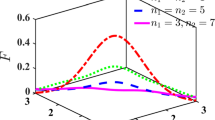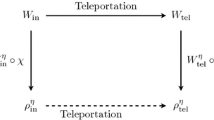Abstract
Continuous variable teleportation with indefinite causal order is studied for an optical system. The relation between input and teleported states is derived. The performance of the teleportation is evaluated in terms of the fidelity. As an example, the teleportation of a coherent state, a squeezed-vacuum state and a Schrödinger-cat state is investigated. The result shows that the indefinite causal order can improve the fidelity of the continuous variable teleportation.


Similar content being viewed by others
Data availability
All data generated or analyzed during this study are included in this published article.
References
Peres, A.: Quantum theory: concepts and methods. Kluwer, Dordrecht (1993)
Streltsov, A., Adesso, G., Plenio, M.B.: Quantum coherence as a resource. Rev. Mod. Phys. 89, 041003 (2014)
Horodecki, R., Horodecki, P., Horodecki, M., Horodecki, K.: Quantum entanglement. Rev. Mod. Phys. 81, 865 (2009)
Reid, M.D., Drummond, P.D., Bowen, W.P., Cavalcanti, E.G., Lam, K.P., Bachor, H.A., Andersen, U.L., Leuchs, G.: The Einstein-Podolsky-Rosen paradox: from concepts to applications. Rev. Mod. Phys. 81, 1727 (2009)
Brunner, N., Cavalcanti, D., Pironio, S., Scarani, V., Wehner, S.: Bell nonlocality. Rev. Mod. Phys. 86, 419 (2014)
Chiribella, G.: Perfect discrimination of no-signalling channels via quantum superposition of causal structures. Phys. Rev. A 86, 040301 (2012)
Ibnouhsein, I., Grinbaum, A.: Information-theoretic constraints on correlations with indefinite causal order. Phys. Rev. A 92, 042124 (2015)
Ebler, D., Salek, S., Chiribella, G.: Enhanced communication with the assistance of indefinite causal order. Phys. Rev. Lett. 120, 120502 (2018)
Goswami, K., Giarmatzi, C., Kewming, M., Costa, F., Branciard, C., Romero, J., White, A.G.: Indefinite causal order in a quantum switch. Phys. Rev. Lett. 121, 090503 (2018)
Jia, D., Costa, F.: Causal order as a resource for quantum communication. Phys. Rev. A 100, 052319 (2019)
Guo, Y., Hu, X.M., Hou, Z.B., Cao, H., Cui, J.M., Liu, B.H., Huang, Y.F., Li, C.F., Guo, G.C., Chiribella, G.: Experimental transmission of quantum information using a superposition of causal orders. Phys. Rev. Lett. 124, 030502 (2020)
Loizeau, N., Grinbaum, A.: Channel capacity enhancement with indefinite causal order. Phys. Rev. A 101, 012340 (2020)
Procopio, L.M., Delgado, F., Enriquez, M., Belabas, N., Levenson, J.A.: Sending classical information via three noisy channels in superposition of causal orders. Phys. Rev. A 101, 012346 (2020)
Felce, D., Vedral, V.: Quantum refrigeration with indefinite causal order. Phys. Rev. Lett. 125, 070603 (2020)
Chapeau-Blondeau, F.: Noisy quantum metrology with the assistance of indefinite causal order. Phys. Rev. A 103, 032615 (2021)
Chapeau-Blondeau, F.: Quantum parameter estimation on coherently superposed noisy channel. Phys. Rev. A 104, 032214 (2021)
Ban, M.: On sequential measurements with indefinite causal order. Phys. Lett. A 403, 127383 (2021)
Mukhopadhyay, C., Pati, A.K.: Superposition of causal order enables perfect quantum advantage in teleportation under very noisy singlets. J. Phys. Commun. 4, 105003 (2020)
Cardoso-Isidoro, C., Delgado, F.: Featuring causal order in teleportation of two quantum teleportation channels. J. Phys. Conf. Series 1540, 012024 (2020)
Braunstein, S.L., Kimble, H.J.: Teleportation of continuous variables. Phys. Rev. Lett. 80, 869 (1998)
Furusawa, A., Sorensen, J.L., Braunstein, S.L., Fuchs, C.A., Kimble, H.J., Polizik, E.S.: Unconditional quantum teleportation. Science 282, 706 (1998)
Ban, M., Sasaski, M., Takeoka, M.: Continuous variable teleportation as a generalized thermalizing quantum channel. J. Phys. A 35, L401 (2002)
Bowen, G., Bose, S.: Teleportation as a depolarizing channel, relative entropy and classical capacity. Phys. Rev. Lett. 87, 267901 (2001)
Hall, M.J.W.: Gaussian noise and quantum-optical communication. Phys. Rev. A 50, 3295 (1994)
Glauber, R.J.: Photon correlations. Phys. Rev. Lett. 10, 84 (1963)
Sudarshan, E.C.G.: Euqivalence of semiclassical and quantum mechanical descriptions of statistical light beams. Phys. Rev. Lett. 10, 277 (1963)
Agarwal, G.S.: Quantum optics. Cambridge Univ. Press, Cambridge (2013)
Yuen, H.P.: Two-photon coherent states of the radiation field. Phys. Rev. A 13, 2226 (1976)
Schumaker, B.L., Caves, C.M.: New formalism for two-photon quantum optics. II. Mathematical foundation and compact notation. Phys. Rev. A 31, 3093 (1985)
Milburn, G.J., Holmes, C.A.: Dissipative quantum and classical Liouville mechanics of the anharmonic oscillator. Phys. Rev. Lett. 56, 2237 (1986)
Yurke, B., Stoler, D.: Generating quantum mechanical superpositions of macroscopically distinguishable states via amplitude dispersion. Phys. Rev. Lett. 57, 13 (1986)
Bužek, V., Vidiella-Barranco, A., Knight, P.L.: Superpositions of coherent states: squeezing and dissipation. Phys. Rev. A 45, 6570 (1992)
Ban, M.: Non-classicality created by quantum channels with indefinite causal order. Phys. Lett. 402, 127381 (2021)
Author information
Authors and Affiliations
Corresponding author
Additional information
Publisher's Note
Springer Nature remains neutral with regard to jurisdictional claims in published maps and institutional affiliations.
A Randomly modulated amplitude channel with indefinite causal order
A Randomly modulated amplitude channel with indefinite causal order
First, we briefly review a quantum channel in which amplitude of an optical system is randomly modulated [24]. If the quantum channel displaces the amplitude of the optical system initialized in a quantum state \(\hat{\rho }_{\text {in}}\) by a complex number \(\beta \), the quantum channel yields the state \(\hat{\rho }_{\text {out}}(\beta ) =\hat{D}(\beta )\hat{\rho }_{\text {in}}\hat{D}^{\dagger }(\beta )\) with the displacement operator \(\hat{D}(\beta )=e^{\beta \hat{a}^{\dagger }-\beta ^{*}\hat{a}}\). Then, when such a displacement occurs with probability \(p(\beta )\) which is normalized by \(\int \frac{d^{2}\beta }{\pi }p(\beta )=1\), the output state of the optical system is given by \(\hat{\rho }_{\text {out}}=\int \frac{d^{2}\beta }{\pi }p(\beta )\hat{D}(\beta ) \hat{\rho }_{\text {in}}\hat{D}^{\dagger }(\beta )\), where the free part of the time-evolution has been ignored. This result is equal to Eq. (1). The detailed derivation and its physical meaning have been discussed in Ref. [24]. Next, we suppose that two quantum channels \(\mathcal {A}\) and \(\mathcal {B}\) sequentially apply to an optical system. The channel \(\mathcal {A}\) displaces amplitude of the optical system by \(\alpha \) with probability \(p(\alpha )\) and the channel \(\mathcal {B}\) by \(\beta \) with probability \(p(\beta )\). It is assumed that which one of the two channels applies first to the system is determined by a state of a control qubit. For instance, when the control qubit is initialized in a computational state \(\vert 0_{c}\rangle \) (\(\vert 1_{c}\rangle \)), the quantum channel \(\mathcal {B}\) (\(\mathcal {A}\)) affects the system first. Then, if the control qubit is prepared in a superposition state \(\vert \xi _{c}\rangle \), the state \(\hat{D}(\alpha ,\beta )(\hat{\rho }_{\text {in}}\otimes \vert \xi _{c}\rangle \langle \xi _{c}\vert )\hat{D}^{\dagger }(\alpha ,\beta )\) is obtained with probability \(p(\alpha )p(\beta )\), where \(\hat{D}(\alpha ,\beta )=\hat{D}(\alpha )\hat{D}(\beta )\otimes \vert 0_{c}\rangle \langle 0_{c}\vert +\hat{D}(\beta )\hat{D}(\alpha )\otimes \vert 1_{c}\rangle \langle 1_{c}\vert \). Hence, the output state of the optical system and the control qubit becomes \(\hat{W}_{\text {out}}=\int \frac{d^{2}\alpha }{\pi } \int \frac{d^{2}\beta }{\pi }p(\alpha )p(\beta ) \hat{D}(\alpha ,\beta )(\hat{\rho }_{\text {in}}\otimes \vert \xi _{c}\rangle \langle \xi _{c}\vert )\hat{D}^{\dagger }(\alpha ,\beta )\), which is equivalent to Eq. (5).
Rights and permissions
Springer Nature or its licensor (e.g. a society or other partner) holds exclusive rights to this article under a publishing agreement with the author(s) or other rightsholder(s); author self-archiving of the accepted manuscript version of this article is solely governed by the terms of such publishing agreement and applicable law.
About this article
Cite this article
Ban, M. Continuous variable teleportation with indefinite causal order. Quantum Inf Process 21, 367 (2022). https://doi.org/10.1007/s11128-022-03721-4
Received:
Accepted:
Published:
DOI: https://doi.org/10.1007/s11128-022-03721-4




